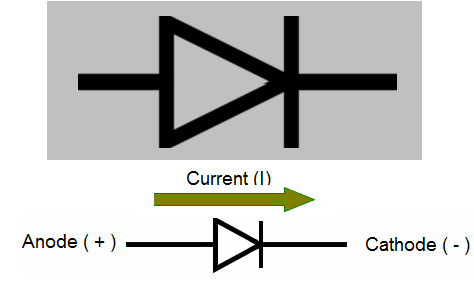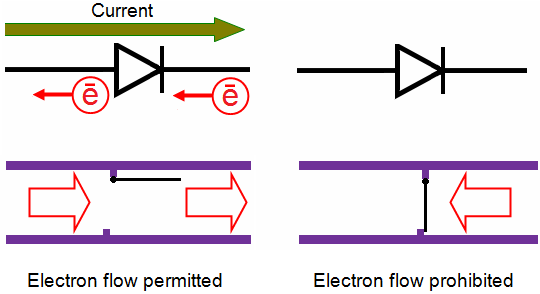DIODE SYMBOLS
A diode is an electrical device allowing current to move through it in one direction with far greater ease than in the other. The most common type of diode in modern circuit design is the semiconductor diode, although other diode technologies exist.
1. DIODE SYMBOLS AND PROPERTIES:
A diode and schematic representation are shown at figure below.

A semiconductor diode consists of a P- N junction and has two terminals, an anode and a cathode. Current flows only from anode to cathode within the diode.
In the symbol of the diode, arrows indicate the direction of electron current flow.

2. TERMINOLOGY:
Consider a electrical lamp placed in a simple battery-lamp circuit, the diode will either allow or prevent current through the lamp, depending on the polarity of the applied voltage.
Diode forward biased: (a) Current flow is permitted; the diode is forward biased. When the polarity of the battery is such that electrons are allowed to flow through the diode, the diode is said to be forward-biased.
Diode reverse biased: (b) Current flow is prohibited; the diode is reversed biased. When the battery is “backward” and the diode blocks current, the diode is said to be reverse-biased.
A diode may be thought of as like a switch: “closed” when forward-biased and “open” when reverse-biased.
This convention holds true for all semiconductor symbols possessing “arrowheads:” the arrow points in the permitted direction of conventional flow, and against the permitted direction of electron flow. Oddly enough, the direction of the diode symbol's “arrowhead” points against the direction of electron flow. This is because the diode symbol was invented by engineers, who predominantly use conventional flow notation in their schematics, showing current as a flow of charge from the positive (+) side of the voltage source to the negative (-).

3. HYDRAULIC ANALOGY:
Diode behavior is analogous to the behavior of a hydraulic device called a check valve. A check valve allows fluid flow through it in only one direction as in Figure below.

Check valves are essentially pressure-operated devices: they open and allow flow if the pressure across them is of the correct “polarity” to open the gate (in the analogy shown, greater fluid pressure on the right than on the left). If the pressure is of the opposite “polarity,” the pressure difference across the check valve will close and hold the gate so that no flow occurs.
Like check valves, diodes are essentially “pressure” operated (voltage-operated) devices. The essential difference between forward-bias and reverse-bias is the polarity of the voltage dropped across the diode.